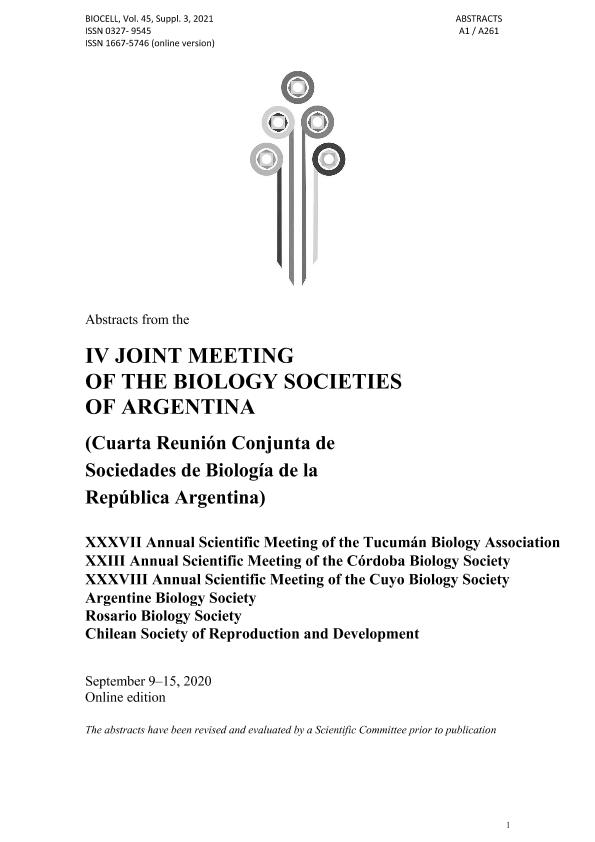Mostrar el registro sencillo del ítem
dc.contributor.author
Laiz Quiroga, Lucía Belén

dc.contributor.author
Gimeno, Brenda Florencia
dc.contributor.author
Martínez León, Eduardo Antonio

dc.contributor.author
Von Meyeren, Micaela

dc.contributor.author
Mutto, Adrián Angel

dc.contributor.author
Bariani, Maria Victoria

dc.contributor.author
Osycka Salut, Claudia Elena

dc.date.available
2022-03-28T16:52:05Z
dc.date.issued
2021
dc.identifier.citation
New Tools for in Vitro Handling and Selection of Cryopreserved Sperm Samples in Equines; IV Joint Meeting of The Biology Societies of Argentina; Mendoza; Argentina; 2020; 47-48
dc.identifier.issn
0327-9545
dc.identifier.uri
http://hdl.handle.net/11336/153951
dc.description.abstract
Cryopreserved sperm (SPZ) are used widely in domestic animals for assisted reproduction techniques (ART). However, cryopreservation procedures negatively affect SPZ quality, causing changes at the structural and molecular levels. Therefore, using cryopreserved SPZ for ART can decrease the efficiency of these techniques as well as the quality of the embryos obtained, being necessary to optimize the handling of this type of sample. Particularly in equines, ICSI is the most used technique for low-quality equine semen samples where SPZ is selected based on their motility and morphology. Physiologically, the oviduct epithelial cells (OEC) are involved in the selection of a population of SPZ suitable for oocyte fertilization, which is released from the oviduct due to the capacitation process. This work aimed to evaluate different conditions for the in vitro manipulation and incubation of equine cryopreserved SPZ and to establish an in vitro OEC culture to select an SPZ population with fertilizing capacity suitable for its use in ART in this species.Regarding the handling and the effect on the motility of post-thawed equine cryopreserved SPZ samples, we used non-capacitating Whitten´s medium, less effect on motility was observed through the time (120 min) when SPZ were incubated at concentrations of 30 mill/ml compared to lower concentrated samples (CASA, p<0.05). Also, the motility decreased by half with centrifugations at 200g longer than 1 min (p<0.05). On the other hand, we have established a culture model of OECs in vitro, in which we demonstrated the expression of epithelial markers (E-cadherin and cytokeratin) by both RT-PCR and immunofluorescence (IF). When we performed SPZ-OEC cocultures, we observed that the attached SPZs were motile and presented intact acrosome (PSA-FITC, IF), suggesting a selection by the oviductal model. Then, the co-cultures were incubated in capacitating conditions (capacitating Whitten´s medium) and the released SPZ population was recovered. Under these conditions, a greater number of live sperm (Hoechst258 assessed by IF), capacitated (activation of PKA and phosphorylation on tyrosine residues by IF), with progressive motility (CASA) and with the intact acrosome (PSA-FITC, IF) compared to the control was observed (p<0.05). Moreover, the decrease in motility through the time was less in these SPZ than in the cryopreserved SPZ incubated in the absence of OECs. This sperm population could be recovered for its use in different ART.Improvements in handling and selection of cryopreserved SPZ not only generate tools to solve the problem that IVF presents in equines, but would also improve efficiency in other ART such as ICSI, allowing the use of a population of higher quality gametes which it would positively impact the quality of the embryos obtained.
dc.format
application/pdf
dc.language.iso
eng
dc.publisher
Tech Science Press

dc.rights
info:eu-repo/semantics/openAccess
dc.rights.uri
https://creativecommons.org/licenses/by/2.5/ar/
dc.subject
CRYOPRESERVED SPERM
dc.subject
HANDLING
dc.subject
OVIDUCT SELECTION
dc.subject
EQUINES
dc.subject.classification
Ciencias Veterinarias

dc.subject.classification
Ciencias Veterinarias

dc.subject.classification
CIENCIAS AGRÍCOLAS

dc.title
New Tools for in Vitro Handling and Selection of Cryopreserved Sperm Samples in Equines
dc.type
info:eu-repo/semantics/publishedVersion
dc.type
info:eu-repo/semantics/conferenceObject
dc.type
info:ar-repo/semantics/documento de conferencia
dc.date.updated
2022-03-16T19:43:54Z
dc.identifier.eissn
1667-5746
dc.journal.volume
45
dc.journal.number
3
dc.journal.pagination
47-48
dc.journal.pais
Estados Unidos

dc.journal.ciudad
Henderson
dc.description.fil
Fil: Laiz Quiroga, Lucía Belén. Consejo Nacional de Investigaciones Científicas y Técnicas. Centro Científico Tecnológico Conicet - La Plata. Instituto de Investigaciones Biotecnológicas. Universidad Nacional de San Martín. Instituto de Investigaciones Biotecnológicas; Argentina
dc.description.fil
Fil: Gimeno, Brenda Florencia. Consejo Nacional de Investigaciones Científicas y Técnicas. Oficina de Coordinación Administrativa Houssay. Instituto de Inmunología, Genética y Metabolismo. Universidad de Buenos Aires. Facultad de Medicina. Instituto de Inmunología, Genética y Metabolismo; Argentina
dc.description.fil
Fil: Martínez León, Eduardo Antonio. Consejo Nacional de Investigaciones Científicas y Técnicas. Oficina de Coordinación Administrativa Houssay. Instituto de Inmunología, Genética y Metabolismo. Universidad de Buenos Aires. Facultad de Medicina. Instituto de Inmunología, Genética y Metabolismo; Argentina
dc.description.fil
Fil: Von Meyeren, Micaela. Universidad Nacional de San Martín. Instituto de Investigaciones Biotecnológicas. - Consejo Nacional de Investigaciones Científicas y Técnicas. Oficina de Coordinación Administrativa Parque Centenario. Instituto de Investigaciones Biotecnológicas; Argentina
dc.description.fil
Fil: Mutto, Adrián Angel. Universidad Nacional de San Martín. Instituto de Investigaciones Biotecnológicas. - Consejo Nacional de Investigaciones Científicas y Técnicas. Oficina de Coordinación Administrativa Parque Centenario. Instituto de Investigaciones Biotecnológicas; Argentina
dc.description.fil
Fil: Bariani, Maria Victoria. Consejo Nacional de Investigaciones Científicas y Técnicas. Oficina de Coordinación Administrativa Houssay. Centro de Estudios Farmacológicos y Botánicos. Universidad de Buenos Aires. Facultad de Medicina. Centro de Estudios Farmacológicos y Botánicos; Argentina
dc.description.fil
Fil: Osycka Salut, Claudia Elena. Consejo Nacional de Investigaciones Científicas y Técnicas. Oficina de Coordinación Administrativa Houssay. Centro de Estudios Farmacológicos y Botánicos. Universidad de Buenos Aires. Facultad de Medicina. Centro de Estudios Farmacológicos y Botánicos; Argentina
dc.relation.alternativeid
info:eu-repo/semantics/altIdentifier/url/https://www.techscience.com/biocell/v45nSuppl.3/44000
dc.conicet.rol
Autor

dc.conicet.rol
Autor

dc.conicet.rol
Autor

dc.conicet.rol
Autor

dc.conicet.rol
Autor

dc.conicet.rol
Autor

dc.conicet.rol
Autor

dc.coverage
Internacional
dc.type.subtype
Reunión
dc.description.nombreEvento
IV Joint Meeting of The Biology Societies of Argentina
dc.date.evento
2020-09-09
dc.description.ciudadEvento
Mendoza
dc.description.paisEvento
Argentina

dc.type.publicacion
Journal
dc.description.institucionOrganizadora
Sociedad de Biología de Cuyo
dc.description.institucionOrganizadora
Sociedad Argentina de Biología
dc.description.institucionOrganizadora
Sociedad de Biología de Córdoba
dc.description.institucionOrganizadora
Sociedad de Biología de Rosario
dc.description.institucionOrganizadora
Asociación de Biología de Tucumán
dc.source.revista
Biocell

dc.date.eventoHasta
2020-09-15
dc.type
Reunión
Archivos asociados
